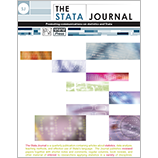
Implementing intersection bounds in Stata
The commands clrbound, clr2bound, and clr3bound provide bound estimates that can be used directly for estimation or to construct asymptotically valid confidence sets. clrtest performs an intersection bound test of the hypothesis that a collection of lower intersection bounds is no greater than zero. The command clrbound provides bound estimates for one-sided lower or upper intersection bounds on a parameter, while clr2bound and clr3bound provide two-sided bound estimates using both lower and upper intersection bounds. clr2bound uses Bonferroni’s inequality to construct two-sided bounds that can be used to perform asymptotically valid inference on the identified set or the parameter of interest, whereas clr3bound provides a generally tighter confidence interval for the parameter by inverting the hypothesis test performed by clrtest. More broadly, inversion of this test can also be used to construct confidence sets based on conditional moment inequalities as described in Chernozhukov, Lee, and Rosen (2013). The commands include parametric, series, and local linear estimation procedures. View all articles by these authors: Victor Chernozhukov, Wooyoung Kim, Sokbae Lee, Adam M. Rosen View all articles with these keywords: clrbound, clr2bound, clr3bound, clrtest, intersection bounds, bound analysis, conditional moments, partial identification, infinite dimensional constraints, adaptive moment selection Download citation: BibTeX RISDownload citation and abstract: BibTeX RIS |